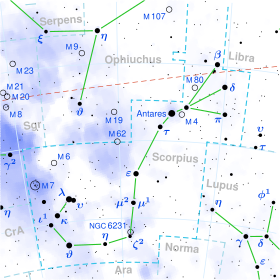Theta Scorpii
| Observation data Epoch J2000 Equinox J2000 |
|
|---|---|
| Constellation | Scorpius |
| Right ascension | 17h 37m 19.12985s |
| Declination | –42° 59′ 52.1808″ |
| Apparent magnitude (V) | 1.84 (1.862 + 6.22) |
| Characteristics | |
| Spectral type | F0 II |
| U−B color index | +0.21 |
| B−V color index | +0.40 |
| Astrometry | |
| Radial velocity (Rv) | +1.4 km/s |
| Proper motion (μ) |
RA: +5.54 mas/yr Dec.: –3.12 mas/yr |
| Parallax (π) | 10.86 ± 1.49mas |
| Distance | approx. 300 ly (approx. 90 pc) |
| Details | |
| Mass | 5.66 ± 0.65 M☉ |
| Radius | 26 R☉ |
| Luminosity | 1,834 L☉ |
| Surface gravity (log g) | 2.4 ± 0.2 cgs |
| Temperature | 7,268 K |
| Rotational velocity (v sin i) | 125 km/s |
| Other designations | |
| Database references | |
| SIMBAD | data |
Theta Scorpii (θ Scorpii, abbreviated Theta Sco, θ Sco), also named Sargas, is a binary star in the southern zodiac constellation of Scorpius. The apparent visual magnitude of this star is +1.87, making it readily visible to the naked eye and one of the brightest stars in the night sky. It is sufficiently near that the distance can be measured directly using the parallax technique, which yields an estimate of roughly 300 light years (90 parsecs) from the Sun.
θ Scorpii (Latinised to Theta Scorpii) is the system's Bayer designation.
It bore the traditional name Sargas, of Sumerian origin. In 2016, the International Astronomical Union organized a Working Group on Star Names (WGSN) to catalogue and standardize proper names for stars. The WGSN approved the name Sargas for this star on 21 August 2016 and it is now so entered in the IAU Catalog of Star Names.
In Chinese astronomy, it is referred to as 尾宿五 (Wěisuwǔ), the Fifth Star of the Tail.
The primary is an evolved bright giant star with a stellar classification of F0 II. With a mass 5.7 times that of the Sun, it has expanded to about 26 times the Sun's radius. It is radiating 1,834 times as much luminosity as the Sun from its outer envelope at an effective temperature of 7,268, giving it the yellow-white hued glow of an F-type star. This star is rotating rapidly, giving it an oblate shape with an equatorial radius 19% larger than the polar radius.
...
Wikipedia

